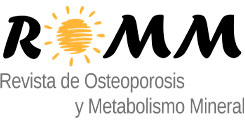Kar E, Ammanamanchi A, Yousif M, Geetha SD, Schwartz K, Mishra AS, et al. From bimodal to unimodal: The transformed incidence of osteosarcoma in the United States. Journal of Bone Oncology. agosto de 2024;47:100613.
Beird HC, Bielack SS, Flanagan AM, Gill J, Heymann D, Janeway KA, et al. Osteosarcoma. Nat Rev Dis Primers. 8 de diciembre de 2022;8(1):77.
Belayneh R, Fourman MS, Bhogal S, Weiss KR. Update on Osteosarcoma. Curr Oncol Rep. junio de 2021;23(6):71.
Mirabello L, Troisi RJ, Savage SA. Osteosarcoma incidence and survival rates from 1973 to 2004: Data from the Surveillance, Epidemiology, and End Results Program. Cancer. abril de 2009;115(7):1531-43.
Cersosimo F, Lonardi S, Bernardini G, Telfer B, Mandelli GE, Santucci A, et al. Tumor-Associated Macrophages in Osteosarcoma: From Mechanisms to Therapy. IJMS. 23 de julio de 2020;21(15):5207.
Picci P, Sangiorgi L, Caldora P. Histopatología del osteosarcoma. 1995;
Chen X, Bahrami A, Pappo A, Easton J, Dalton J, Hedlund E, et al. Recurrent Somatic Structural Variations Contribute to Tumorigenesis in Pediatric Osteosarcoma. Cell Reports. abril de 2014;7(1):104-12.
Behjati S, Tarpey PS, Haase K, Ye H, Young MD, Alexandrov LB, et al. Recurrent mutation of IGF signalling genes and distinct patterns of genomic rearrangement in osteosarcoma. Nat Commun. 23 de junio de 2017;8(1):15936.
Rothzerg E, Pfaff AL, Koks S. Innovative approaches for treatment of osteosarcoma. Exp Biol Med (Maywood). febrero de 2022;247(4):310-6.
Smith MA, Seibel NL, Altekruse SF, Ries LAG, Melbert DL, O’Leary M, et al. Outcomes for Children and Adolescents with Cancer: Challenges for the Twenty-First Century. JCO. 20 de mayo de 2010;28(15):2625-34.
Kathiresan N, Selvaraj C, Pandian S, Subbaraj GK, Alothaim AS, Safi SZ, et al. Proteomics and genomics insights on malignant osteosarcoma. En: Advances in Protein Chemistry and Structural Biology [Internet]. Elsevier; 2024 [citado 7 de marzo de 2025]. p. 275-300. Disponible en: https://linkinghub.elsevier.com/retrieve/pii/S1876162323000652
DOI: 10.1016/bs.apcsb.2023.06.001
Kansara M, Teng MW, Smyth MJ, Thomas DM. Translational biology of osteosarcoma. Nat Rev Cancer. noviembre de 2014;14(11):722-35.
Klein MJ, Siegal GP. Osteosarcoma: Anatomic and Histologic Variants. Am J Clin Pathol. abril de 2006;125(4):555-81.
Gao YM, Pei Y, Zhao FF, Wang L. Osteoclasts in Osteosarcoma: Mechanisms, Interactions, and Therapeutic Prospects. CMAR. noviembre de 2023;Volume 15:1323-37.
DOI: 10.2147/CMAR.S431213
Hernández-Gil IFT, Gracia MAA, Jerez B. Bases fisiológicas de la regeneración ósea I. Histología y fisiología del tejido óseo. Med Oral Patol Oral Cir Bucal.
Wu C, Gong S, Duan Y, Deng C, Kallendrusch S, Berninghausen L, et al. A tumor microenvironment-based prognostic index for osteosarcoma. J Biomed Sci. 13 de abril de 2023;30(1):23.
Miwa S, Shirai T, Yamamoto N, Hayashi K, Takeuchi A, Igarashi K, et al. Current and Emerging Targets in Immunotherapy for Osteosarcoma. Journal of Oncology. 1 de enero de 2019;2019:1-8.
Chim LK, Williams IL, Bashor CJ, Mikos AG. Tumor-associated macrophages induce inflammation and drug resistance in a mechanically tunable engineered model of osteosarcoma. Biomaterials. mayo de 2023;296:122076.
Champagne CM, Takebe J, Offenbacher S, Cooper LF. Macrophage cell lines produce osteoinductive signals that include bone morphogenetic protein-2. Bone. enero de 2002;30(1):26-31.
Chen C, Xie L, Ren T, Huang Y, Xu J, Guo W. Immunotherapy for osteosarcoma: Fundamental mechanism, rationale, and recent breakthroughs. Cancer Letters. marzo de 2021;500:1-10.
Wang Z, Wang Z, Li B, Wang S, Chen T, Ye Z. Innate Immune Cells: A Potential and Promising Cell Population for Treating Osteosarcoma. Front Immunol. 16 de mayo de 2019;10:1114.
Buddingh EP, Kuijjer ML, Duim RAJ, Bürger H, Agelopoulos K, Myklebost O, et al. Tumor-Infiltrating Macrophages Are Associated with Metastasis Suppression in High-Grade Osteosarcoma: A Rationale for Treatment with Macrophage Activating Agents. Clinical Cancer Research. 15 de abril de 2011;17(8):2110-9.
Huang Q, Liang X, Ren T, Huang Y, Zhang H, Yu Y, et al. The role of tumor-associated macrophages in osteosarcoma progression - therapeutic implications. Cell Oncol. junio de 2021;44(3):525-39.
Tu B, Peng ZX, Fan QM, Du L, Yan W, Tang TT. Osteosarcoma cells promote the production of pro-tumor cytokines in mesenchymal stem cells by inhibiting their osteogenic differentiation through the TGF-β/Smad2/3 pathway. Experimental Cell Research. enero de 2014;320(1):164-73.
Anand N, Peh KH, Kolesar JM. Macrophage Repolarization as a Therapeutic Strategy for Osteosarcoma. IJMS. 2 de febrero de 2023;24(3):2858.
Meyers PA, Schwartz CL, Krailo MD, Healey JH, Bernstein ML, Betcher D, et al. Osteosarcoma: The Addition of Muramyl Tripeptide to Chemotherapy Improves Overall Survival—A Report From the Children’s Oncology Group. JCO. 1 de febrero de 2008;26(4):633-8.
Punzo F, Bellini G, Tortora C, Pinto DD, Argenziano M, Pota E, et al. Mifamurtide and TAM-like macrophages: effect on proliferation, migration and differentiation of osteosarcoma cells. Oncotarget. 18 de febrero de 2020;11(7):687-98.
Ashique S, Faiyazuddin M, Afzal O, Gowri S, Hussain A, Mishra N, et al. Advanced nanoparticles, the hallmark of targeted drug delivery for osteosarcoma-an updated review. Journal of Drug Delivery Science and Technology. septiembre de 2023;87:104753.
Feng C, Jiang Y, Wang T, Tian D, Shen C, Wang Y, et al. Recent advances on nanostructured biomaterials in osteosarcoma treatment. Coordination Chemistry Reviews. octubre de 2023;493:215315.
Wang SY, Hu HZ, Qing XC, Zhang ZC, Shao ZW. Recent advances of drug delivery nanocarriers in osteosarcoma treatment. J Cancer. 2020;11(1):69-82.
DOI: 10.7150/jca.36588
Hori T, Kondo T, Lee H, Song CW, Park HJ. Hyperthermia enhances the effect of β-lapachone to cause γH2AX formations and cell death in human osteosarcoma cells. International Journal of Hyperthermia. febrero de 2011;27(1):53-62.
Seoane S, Díaz-Rodríguez P, Sendon-Lago J, Gallego R, Pérez-Fernández R, Landin M. Administration of the optimized β-Lapachone-poloxamer-cyclodextrin ternary system induces apoptosis, DNA damage and reduces tumor growth in a human breast adenocarcinoma xenograft mouse model. European Journal of Pharmaceutics and Biopharmaceutics. agosto de 2013;84(3):497-504.
Silva VL, Al-Jamal WT. Exploiting the cancer niche: Tumor-associated macrophages and hypoxia as promising synergistic targets for nano-based therapy. Journal of Controlled Release. mayo de 2017;253:82-96.
Tsai CF, Chen GW, Chen YC, Shen CK, Lu DY, Yang LY, et al. Regulatory Effects of Quercetin on M1/M2 Macrophage Polarization and Oxidative/Antioxidative Balance. Nutrients. 24 de diciembre de 2021;14(1):67.
Covarrubias A, Byles V, Horng T. ROS sets the stage for macrophage differentiation. Cell Res. agosto de 2013;23(8):984-5.
Díaz-Rodríguez P, Landin M. Smart design of intratumoral thermosensitive β-lapachone hydrogels by Artificial Neural Networks. International Journal of Pharmaceutics. agosto de 2012;433(1-2):112-8.
DOI: 10.1016/j.ijpharm.2012.05.008
Aljabali AA, Obeid MA, Bashatwah RM, Serrano-Aroca Á, Mishra V, Mishra Y, et al. Nanomaterials and Their Impact on the Immune System. IJMS. 19 de enero de 2023;24(3):2008.
Bordon G, Berenbaum F, Distler O, Luciani P. Harnessing the multifunctionality of lipid-based drug delivery systems for the local treatment of osteoarthritis. Biomedicine & Pharmacotherapy. diciembre de 2023;168:115819.
Cummings RD. The mannose receptor ligands and the macrophage glycome. Current Opinion in Structural Biology. agosto de 2022;75:102394.
Fan S, Han H, Yan Z, Lu Y, He B, Zhang Q. Lipid-based nanoparticles for cancer immunotherapy. Medical Review. 27 de junio de 2023;3(3):230-69.
 Número de descargas:
1900
Número de descargas:
1900
 Número de visitas:
806
Número de visitas:
806
 Citas:
0
Citas:
0

 Español
Español English
English

